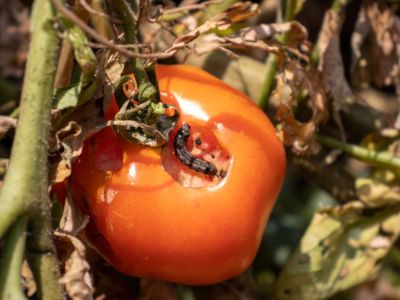Tomato Pinworm Identification
In warmer climes, the tomato pinworms spend the winter as pupae at the soil’s surface. Where the winter weather is too cold for survival, the pupae hide in the dirt floors and plant detritus of the greenhouse. The small grey brown moths lay their eggs on the underside of leaves during the night and because of their tiny size, the eggs are hardly noticeable. It is because of this tomato pinworm control rarely begins at this stage. It’s not until the larval stages that damage begins to mount and when the worms in tomato’s leaves leave their tunnels behind, the evidence is clear. During the next stage of development, the tomato eating worms drill pinholes into the stems, buds, and fruit and eat the flesh until they are ready to pupate or move on to the next stage of development. While leaf damage is of little importance, the damage to the fruit crop can be devastating. In areas where the moths are prevalent, growers must be vigilant with tomato pinworm control because these tiny insects multiply at a remarkable rate and can produce up to eight generations a year.
Tomato Pinworm Control
The first step toward tomato pinworm control is cultural. End of season clean-up is essential for the prevention of future contamination. Garden debris should be cleared, burned, and the soil should be turned under to deeply bury any overwintering pupae of the tomato eating worms. For the following planting season, carefully inspect all hothouse grown seedlings before transplanting them into the bed to avoid transfer of the eggs. Continue to survey the foliage after transplant for the mines and folded leaf shelters that indicate an infestation. Conduct weekly inspections until signs of the worms on tomato plant’s leaves are discovered. If you find two or three worms on tomato plants in each row, it’s time to apply treatment. Pheromone traps have been used effectively in larger field plantings, but are impractical for smaller homestead gardens. Once evidence of the worms in tomatoes is discovered, chemical treatment is called for. Broad spectrum insecticides can be used successfully to kill the tiny worms on tomatoes but must be applied at regular intervals throughout the season. If crops continue to show signs of damage, the narrow spectrum insecticide abamectin can be used, but this is rarely necessary in the home garden. For the organic gardener, garden cleanliness is a must. Remove brown and curled leaves daily and pick any visible worms by hand. Lastly, for those wondering is it harmful to ingest a pinworm from a tomato, the answer is a resounding no! Tomato pinworms are infectious only to Solenaceous plants and NOT to humans. While it might give you the willies to see half of one after you have bitten into a tomato, tomato pin worms are not poisonous to people.
